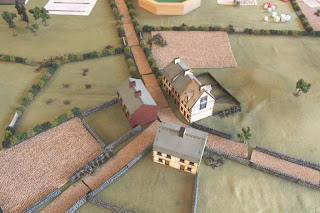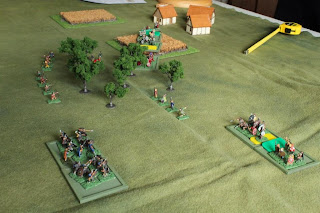This was my second VBCW game using Chain of Command. Once again we played the patrol scenario using Anglican League and BUF platoons with no supports. So a fairly simple set-up with both sides evenly matched.
 |
Both sides' objective was straightforward; take & hold the village. Each ended up with three jump offs points strung out across the ground on their sides of the village; both rolled to have their patrol markers enter in the central section of the table.
The Anglicans began deploying a section of un-uniformed local militia (acting as just one team) and then a section of uniformed militia into the ground behind the village. The uniformed boys would soon head into the white building using their Lewis gun to dominate the road into the village.
The BUF took a similar approach, deploying their un-uniformed locals on the same side as their Anglican counterparts while using a uniformed section to approach the village from the other side.
Both sides approached cautiously. The BUF began to move their local militia around the hedges towards their opposite numbers while their uniformed colleagues approach tactically from the other side. A second uniformed section of Anglicans was deployed to contest the approaches and they sent their rifle team forward. So far it was all a bit tiptoing around.
At last contact is made. The BUF fire upon the Anglican rifle team and it begins to look as though the Anglicans might be over-extended as the BUF deploy their last section which advances towards the hill beyond the Anglican right.
Meanwhile the two teams of locals faced off against each other. They traded shots against each other from cover for the rest of the game but not to any very decisive effect.
On the Anglican right crunch time approached as the two BUF sections closed in on one Anglican section which looked as though it might be caught in the open. Meanwhile another Anglican section rushes across the street into the row of houses which overlook the BUF. ...But they are too late the BUF came over the hill and caught the Anglicans in close combat. The Anglicans were already worn down somewhat by fire from the 1st BUF section. Their rifles were all but wiped up and the Lewis team ran back for cover, badly shocked.
There wass then an uneven firefight between the two BUF sections and the Anglicans in the house which wore the Anglicans down again before another charge into close combat finished off the Anglicans. At that we called it a day and the Anglican local militia withdrew.
My thanks to John & Roger for playing; my apologies that I didn't always get photos at the the crucial points (eg the close combats) but I hope this captures the flavour. Next time support elements will be available (they are now on my painting table). My thanks to Jackie for helping to improve the photoes.



















































